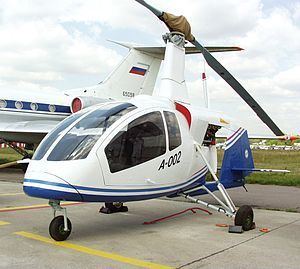Top speed 210 km/h First flight April 21, 2002 | Length 4.98 m Manufacturer Irkut Corporation | |
 | ||
The Irkut A-002 is a three-seat, pusher configuration autogyro developed in Russia through the 2000s by the United Constructor Bureau for Light Aircraft team of the Irkutsk Aircraft Production Association (IAPO) "Irkut" as the first independent product. The take-off from a place is possible when speed of a wind exceeds 8 m/s, otherwise running start up to 15 m is necessary. The riveted covering is made of duralumin. The first produced consignment consisted of five autogyros. The A-002M is a further development.
Contents
Design and development
The A-002 has an enclosed, streamlined cabin accessed by large, windowed side doors. The two front seats have dual control and there is a third seat behind. The fully enclosed, pusher configuration flat four AviaSmart engine is placed behind the cabin with a pair of cooling air intakes above its roof. The propeller thrustline is at cabin roof height. The two-blade rotor is mounted on a tall streamlined pylon at the rear of the cabin. In flight, the rotor is undriven but it can be spun up by the engine for jump starts made with no take-off run. Without this spin-up, take-off requires a run of 30 m (100 ft).
The A-002 has composite tail surfaces mounted on a short boom joined to the bottom of the cabin/engine pod. The fin carries a mass- and horn-balanced rudder and an all-moving tailplane at ⅓ fin height. The A-002 has a fixed, wide track tricycle undercarriage with mainwheels on cantilever spring legs.
The date of the first flight was originally announced as 21 April 2002 but later revised by the manufacturer to 6 July 2002. Production of five A-002s began in August 2002 but no deliveries were made until 2004, when production was halted for further development. Several revisions have been made including much enlarged engine air intakes and the addition of endplate fins to the tailpane. The maximum take-off weight (MTOW) of the A-200 has increased from 900 kg (1,984 lb) to 950 kg (2094 lb) and both the rotor and fuselage have been significantly extended. The more recent A-002M upgrade has further raised the MTOW to 1,030 kg (2,270 lb). There have also been tests of four- and six-bladed propellers.
In 2005 the autogyro project participated in the Russian Innovation Contest where it was declared that at least 150 copies should be sold to pay back the project. In 2006 a renewed version with an AviaSmart engine and a new extended main rotor was named A-002M. In 2008 it was declared about the certification of such autogyro type that year according to the actual aviation rules, however, even by 2012 the certificate has not been received yet. In 2010 they published a specification for more heavy and expensive version of A-002M. The possibility of jump take-off remained, but it is not considered regular any more due to enhanced load on the bearing structure. It was also reported about developing of the unmanned version. One case of the autogyro's experimental operation by the IrkutskEnergo company in 2006 is known; no further cooperation with this company has been reported ever.
Operational history
By late 2003 twenty A-002s had been ordered by Susuman Susumanzoloto OAO, a mining company who had received two, and by Irkutskehenergo OAO, who had received another two for power line inspections. Five had been delivered by 2007.
Variants
Failures and incidents
On July 24, 2012 at 17:15 local time the autogyro Irkut-A002M made an emergency landing to the moorland near Bokovo, the Irkutsk region. The one-pilot crew didn't suffer. The preliminary version stated that the failure was caused by a crack in the oil header of the main rotor forced start drive, which entailed oil leakage in the autogyro's general oil system. The unexperienced pilot didn't notice loss of oil pressure and continued the flight. The apparatus crash-landed on the main rotor autorotation and suffered severe damages due to poor piloting technique.
Specifications (A-002M prototype)
Data from Jane's All the World's Aircraft 2011/12
General characteristics
Performance
